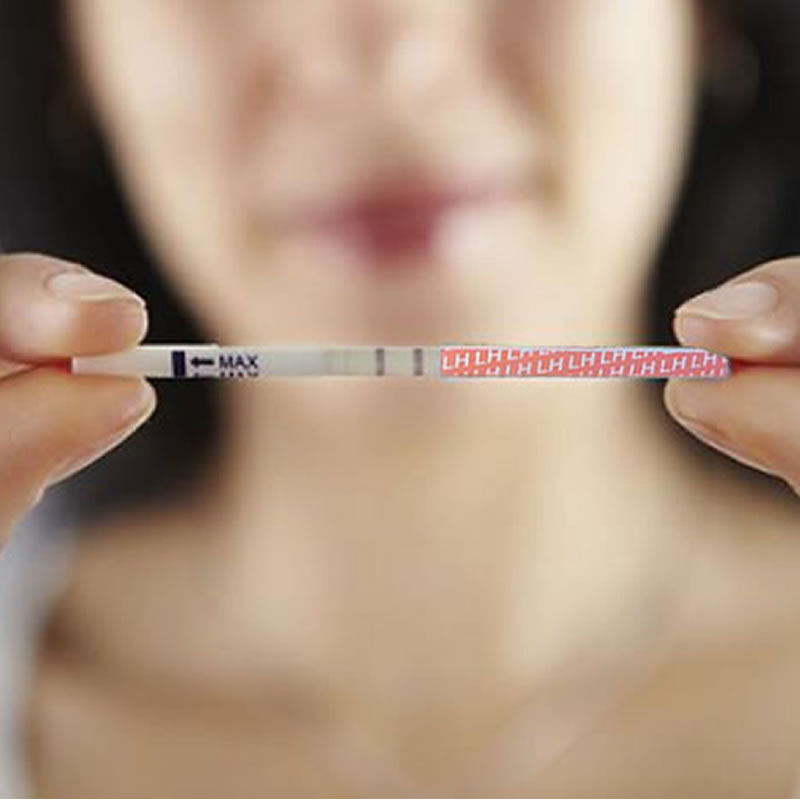Ovulation Symptoms - What are they and when do they appear?

Ovulation symptoms are the way to know that the egg is ready for conception.
Usually, in 28-day cycles, symptoms appear on the 14th day after the end of the period and last sometimes for one day and sometimes for the entire cycle of fertile days. Ovulation is the release of an egg from the ovaries, with the purpose of fertilization. Knowing the symptoms so you can tell when your body is in the ovulation phase is very beneficial for couples trying to conceive. Another way to tell if you're ovulating is with ovulation tests from HomeTest, which you can find in strip, midstream and digital forms.

What is ovulation?
Ovulation is a normal process that takes place during a woman's menstrual cycle. It describes the process by which a mature egg is released from the ovary and prepared for fertilization. It is the most important event of the reproductive cycle, as it contributes to conception and pregnancy. Ovulation occurs about halfway through the menstrual cycle, since it lasts 28 days and occurs on the 14th day. It can happen at different times in different women and in the same woman from cycle to cycle.
The hormones produced are follicle-stimulating hormone (FSH) and luteinizing hormone (LH) and they regulate the ovulation process. FSH promotes the growth and maturation of follicles at the start of the menstrual cycle. As the follicles grow, they release estrogen, which instructs the endometrium, the lining of the uterus, to thicken in anticipation of a future pregnancy. The dominant follicle ruptures and releases the mature egg into the fallopian tube when the estrogen level exceeds a certain threshold, causing an LH surge.
When you recognize ovulation symptoms and track your cycle, you have a better chance of conceiving by planning intercourse around your fertile days and around ovulation.

What are the symptoms of ovulation?
Ovulation symptoms can be different from woman to woman and in some cases there may be no symptoms at all. There are some very common ovulation symptoms that are easy to spot and look like pregnancy symptoms. The best way to be sure about the symptoms you are experiencing is with an ovulation test. In our online store you can find digital ovulation tests, in films, and in midstream. Below we will see the most common symptoms that you may experience and that usually betray the beginning of ovulation.
Changes in body temperature
After ovulation your core body temperature rises by a small degree that you may be able to detect. You can monitor the temperature in your body with a specialized thermometer to know if you are ovulating. As many factors play a role in body temperature fluctuations, you should check it in the morning, before getting out of bed.
Changes in the cervical mucus
During the menstrual cycle the cervical mucus changes in texture and appearance, with the period of ovulation being the most pronounced. The reason it changes during ovulation is to become cleaner, thinner and more elastic, and to resemble raw egg white. This type of mucus promotes sperm motility and indicates higher fertility.
Abdominal Pain - Mittelschmerz Pain
This is a condition called mittelschmerz, or mild abdominal pain, and it affects some women. Usually the pain occurs only on one side of the lower abdomen and can last from a few hours to a few days. This discomfort is caused by the egg leaving the ovary and passing through the fallopian tube.

Breast tenderness
Fluctuations in a woman's hormones during ovulation can cause breast tenderness and even swelling. During the period of ovulation, the breast shows the same symptoms as those of pregnancy or period.
Increased libido
During ovulation many women experience an increased libido. Such a change may be due to an increase in hormone levels, such as an increased percentage of estrogen. It is a normal change that helps conception.
Mood swings - Hormonal fluctuations
Hormonal fluctuations, such as those in estrogen and progesterone, can affect mood swings and emotional changes. During ovulation, some women may experience mood swings, irritability or even euphoria.

Increased sensitivity of senses
Some women claim that during ovulation, their senses become more intense. Certain tastes or smells may become more intense and pleasant, while in some cases causing discomfort. Remember that not all women experience the same ovulation symptoms and pregnancy symptoms and some may not feel anything at all. Every body is different and sometimes we may misunderstand the symptoms we feel or confuse them with those of pregnancy. Additionally, individual factors such as stress, medication, and underlying health conditions can affect the presence or intensity of ovulation symptoms.

When do ovulation symptoms occur and how long do they last?
Ovulation symptoms can appear even a few days before ovulation. Their intensity and duration varies from woman to woman, as well as the variety of symptoms that appear. Typically, they can last for a few hours to a few days.
How is ovulation calculated
Ovulation is calculated based on your menstrual cycle and its duration. The first day of your period marks the start of your menstrual cycle, which ends the day before your next period starts. Usually, ovulation occurs in the middle of your menstrual cycle (more specifically 14 days before your next period starts). With the following steps, you can roughly track your next ovulation.
1. Start by recording your last 3-6 menstrual cycles. Count the days of each cycle from the first day of the period to the day before the next period.
2. Calculate the average length of your cycles. Then add up the cycle times and divide the sum by the number of cycles you calculated. It is important not to have large deviations from cycle to cycle.
3. Subtract 14 days from the day your period appears to your average cycle length. The value you found is the estimate for your next ovulation.
It is important to note that this method provides a rough estimate of ovulation and may not be accurate for everyone. If you are trying to conceive or have concerns about your fertility, it is recommended that you use a reliable hometest ovulation test or consult a health professional for more precise instructions.
What is an ovulation test and how does it work
The ovulation test is a tool used to detect the surge in luteinizing hormone (LH) that occurs before ovulation. It helps you predict possible ovulation and allows you to determine your fertile window.

See how the ovulation test works:
Right timing
Ovulation tests are usually used a few days before the expected ovulation date. The time varies depending on the length of your menstrual cycle. For example, if you have a normal 28-day cycle, you might start testing around day 11 or 12.
Luteinizing hormone (LH)
Ovulation tests detect the surge of LH, a hormone produced by the pituitary gland, which triggers the release of an egg from the ovary. LH levels rise about 24 to 36 hours before ovulation.
Test procedure
Ovulation tests come in a variety of formats, including test strips, midstream, or digital. The test procedure involves either collecting a urine sample and dipping the tip of the test in the sample, or placing the test directly in the urine flow (depending on the test type).
Ovulation test results
After the period of time mentioned in the instructions for use has passed, the ovulation test will display the results. Most tests use lines or symbols to indicate the presence or absence of LH. When a test is positive, it means that the LH surge has been detected, indicating that ovulation is likely to occur within the next 24 to 36 hours.
Interpretation
It is important to follow the instructions for use provided by the manufacturer to avoid misdiagnosis or interpretation. The instructions will provide guidance on how to interpret your ovulation test results and how to identify your most fertile days in your cycle.
While ovulation tests are useful for predicting when ovulation is likely to occur, they do not confirm that it has occurred. Additional methods, such as monitoring your basal body temperature or monitoring cervical mucus changes, can be used in conjunction with ovulation tests to provide a more complete picture of your fertile days.
If you have concerns about your menstrual cycle or fertility, it's a good idea to consult your doctor for personalized advice and guidance.

What is luteinizing hormone (LH)
Luteinizing hormone (LH) is a hormone of which its levels peak before ovulation. LH plays a key role in the menstrual cycle and ovulation. LH levels rise in the middle of the menstrual cycle, causing the release of a mature egg from the ovary. which is known as ovulation. Monitoring LH levels can be helpful in predicting ovulation and determining fertile days. Ovulation tests detect the rise in LH levels in the urine, indicating that ovulation is likely to occur within the next 24 to 36 hours. Luteinizing hormone (LH) levels can vary during the menstrual cycle and from person to person.
0 comment(s)